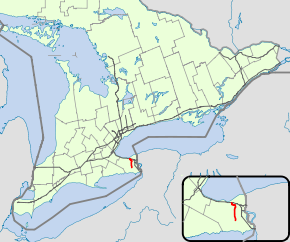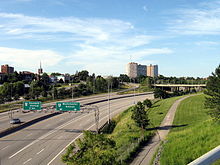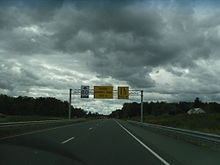- Ontario Highway 406
-
Highway 406 
Route information Length: 26.0 km[2] (16.2 mi) Existed: December 7, 1965[1] – present Major junctions South end: East Main Street in Welland  Highway 58 – Thorold
Highway 58 – ThoroldNorth end:  Queen Elizabeth Way in St. Catharines
Queen Elizabeth Way in St. CatharinesHighway system Ontario provincial highways
400-series • Former←  Highway 405
Highway 405Highway 407  →
→King's Highway 406, also known as Highway 406, is a 400-series highway in the Canadian province of Ontario connecting Welland with St. Catharines. It is one of two 400-series highways with at-grade crossings (the other being Highway 420)
Highway 406 is the primary north-south route though the central portion of the Niagara Peninsula, connecting Welland, Thorold and downtown St. Catharines to the Queen Elizabeth Way (QEW). The section through St. Catharines wraps through the Twelve Mile Creek valley in a winding route, and is therefore posted at 80 km/h (50 mph) rather than the typical 100 km/h (60 mph) speed limit. The northbound transition to this lower speed limit has been the scene of many serious accidents.
Contents
Route description
Highway 406 is unique as the only 400-series highway with two lane sections and with an at-grade rail crossing. The highway is heavily travelled within St. Catharines, but volumes drop considerably south of the city.[2] The speed limit on Highway 406 varies from 80 km/h (50 mph) to 100 km/h (62 mph). It is patrolled by the Ontario Provincial Police.
The 406 designation begins at East Main Street in Welland at a signalized intersection immedietely west of East Main Street Tunnel beneath the Welland Canal. From here the two lane undivided road veers northeast and travels parallel to the canal. Two golf courses separate the canal. As the highway passes to the west of them, it jogs to the west and crosses a Trillium Railway spur, and meets Daimler Parkway and Woodlawn Road at an at-grade intersection. Soon after, it crosses the Welland River and then the former channel of the canal, which was replaced by the current Welland By-Pass in the 1970s.[3]
The highway curves to the northwest as it passes through thick forest, and meets an at-grade intersection with Merritt Road (formerly Highway 58), which is currently being rebuilt as a grade-separated interchange.[4] After this, it returns to its northward orientation and passes the final at-grade intersection, Niagara Regional Road 63 (Port Robinson Road).[3]
North of Port Robinson Road, Highway 406 widens to four lanes and a median opens in the centre, making it a controlled access freeway. The forests break and the freeway continues straight north for 7 km (4.3 mi) through a mostly agricultural area. Along the straightaway are interchanges with former Highway 20 and Niagara Regional Road 67 (Beaverdams Road). The freeway crosses over Lake Gibson, infamous for its connection with the crimes of Paul Bernardo, and curves to the northeast. It passes beneath Niagara Regional Road 71 (St. Davids Road) and Highway 58 at a complicated interchange as it descends the Niagara Escarpment, a World Biosphere Reserve, and enters St. Catharines.[3]
Within St. Catharines, Highway 406 twists frequently, entering the Twelve Mile Creek valley south of a complicated interchange with Westchester Avenue and Geneva Street and curving west. Within the valley, the freeway features a lower design speed and reduced speed limit. It passes beneath the high-level St. Paul Street bridge, crosses the creek and intersects Fourth Avenue. Exiting the creek valley, the freeway parallels Fourth Avenue for a 1 kilometre (0.62 mi), gradually curves to the north and ends 3 km (1.9 mi) to the north at the QEW.[3]
History
Planning for Highway 406 began in early 1959, when Minister of Highways Fred M. Cass presented the Ontario Roads and Streets report to the Ontario Legislative Assembly on March 16, outlining highways needs for the province over 20 years. One of the planned routes was a freeway to link Highway 3 in Port Colborne with the QEW, travelling alongside the Welland Canal. By 1961, route studies and planning were well underway.[5] The complicated work through the Twelve Mile Creek valley took several years of work; the first section, between Geneva Street and St. Davids Road, opened December 7, 1965. This was followed several years later by an extension south to Beaverdams Road, which opened November 21, 1969.[1]
The highway was eventually extended south as a Super 2 to north of the Welland River, where it curved west along Merritt Road and became Highway 58.[6][7]
During the early 1980s, construction began on the section of Highway 406 between Geneva Street and the QEW. This section included the construction of several large bridges over the widened ravine,[8] a curving structure over Twelve Mile Creek, and the first Single-Point Urban Interchange (SPUI) in Ontario (the only other SPUI is located on Airport Parkway in Ottawa). The original design plans for Highway 406 called for this section to follow the creek valley the full distance to the QEW, interchanging with it east of Martindale Road. Instead, the alignment was moved west of the city. Realignments to several streets in St. Catharines were completed in advance of construction on overpasses, ramps and the bridges over Twelve Mile Creek. This work was finished in late 1983. Paving took place during the summer of 1984, and the route was opened to traffic in October 1984.[8]
During the late 1980s, plans arose to connect Highway 406 with East Main Street in the eastern end of Welland. Construction on this two-laned segment, which included an at-grade railway crossing and an intersection with Woodlawn Road, was completed in 1991, resulting in a discontinuous segment from the remainder of the highway. Construction of a structure over the Welland River and old Welland Canal began soon thereafter. The two segments of Highway 406 were united in 1995.
Future
Several other 400-series highways were originally constructed with two lane sections; Highway 410 is a notable and recent examples of this. However, Highway 406 is the only remaining 400-series highway featuring at-grade intersections and two lane sections. The original intention was to "twin" this two lane section shortly after it was constructed in the early-1970s. Plans were deferred multiple times, until the project resumed in the early-2000s. The first phase of this twinning opened to traffic in 2007, extending the four lane highway from its previous convergence south of Beaverdams Road to a point north of Port Robinson Road. South of that point, the route remains a conventional two-lane highway with at-grade intersections.
In May 2009 the Ministry of Transportation of Ontario announced that the section from Port Robinson road to East Main Street in Welland will be converted to a full freeway. Work on the Merritt Road overpass began in September 2009,[4] with the bulk of the work to commence in 2011 and completion targeted for 2013.[9][10]
Exit list
Because Highway 406's northern terminus is tied at the QEW, whereas the southern terminus has a planned southward extension, exit numbers are posted from the north to the south. Despite this, the MTO distance tables label the highway from south the north,[2] as does this table. The entirety of Highway 406 is located within the Regional Municipality of Niagara.[3]
Location[3] km[2] Exit Destinations Notes Welland 0 Regional Road 27 (East Main Street) – Welland At-grade; to be converted to a roundabout 2 Regional Road 41 (Woodlawn Road) At-grade; interchange under construction Thorold 4 Regional Road 37 (Merritt Road) – Holland At-grade; interchange under construction; south end of former  Highway 58 concurrency
Highway 58 concurrency5 Port Robinson Road At-grade; intersection to be removed and replaced with overpass; formerly Regional Road 63 8 17 Regional Road 20 (Canboro Road) – Niagara Falls, Fonthill Formerly  Highway 20; north end of former
Highway 20; north end of former  Highway 58 concurrency
Highway 58 concurrency11 14 Regional Road 67 (Beaverdams Road) 15 11B Regional Road 71 West (St. David's Road) Northbound access St. Catharines 11B  Highway 58
Highway 5815 10  Highway 58 south – Thorold, Niagara Falls
Highway 58 south – Thorold, Niagara FallsSouthbound access 17 9 Regional Road 89 (Glendale Avenue) 19 6 Regional Road 91 (Westchester Avenue) Exit 6A northbound; no northbound entrance from Westchester Avenue 20 6B Regional Road 46 (Geneva Street) Northbound access 21 4 Regional Road 77 (4th Avenue) 25  Queen Elizabeth Way – Niagara Falls, Toronto
Queen Elizabeth Way – Niagara Falls, Toronto1.000 mi = 1.609 km; 1.000 km = 0.621 mi References
- ^ a b AADT Traffic Volumes 1955–1969 And Traffic Collision Data 1967–1969. Ontario Department of Highways. 1971. p. 12.
- ^ a b c d Ministry of Transportation of Ontario (2004). "Annual Average Daily Traffic (AADT) counts". Government of Ontario. http://www.raqsb.mto.gov.on.ca/techpubs/TrafficVolumes.nsf/tvweb?OpenForm&Seq=5. Retrieved February 26, 2010.
- ^ a b c d e f Peter Heiler (2010). Ontario Back Road Atlas (Map). Cartography by MapArt. p. 19, section R33–T34. ISBN 978-1-55198-226-7.
- ^ a b "Widening Highway 406 Starts With New Thorold Bridge". Government of Ontario. September 4, 2009. http://news.ontario.ca/mto/en/2009/09/widening-highway-406-starts-with-new-thorold-bridge.html. Retrieved April 26, 2011.
- ^ Annual Report. Department of Highways. March 31, 1961. http://books.google.com/books?id=ngAjAQAAIAAJ&q=%22Highway%20406%22&dq=Highway%20406%20annual%20report%20Ontario&source=gbs_slider_thumb. Retrieved July 29, 2011.
- ^ Microsoft (July 1, 1986). Southern Terminus of Highway 406 in 1986 (Map). Cartography by United States Geological Survey. http://msrmaps.com/image.aspx?T=2&S=13&Z=17&X=402&Y=2978&W=1. Retrieved July 29, 2010.
- ^ Jackson, John N (1997). The Welland Canals and their communities. University of Toronto Press. p. 447. ISBN 0-8020-0933-6. http://books.google.com/books?id=o-sI64yldu4C&pg=PA447&dq=Highway+406&hl=en&ei=rDFSTMDgCsSblge32dCcBQ&sa=X&oi=book_result&ct=result&resnum=3&ved=0CC0Q6AEwAg#v=onepage&q=Highway%20406&f=false. Retrieved April 26, 2011.
- ^ a b PCI Journal. 29. Prestressed Concrete Institute. 1984. p. 46. "The bridges were opened to traffic in October 1984 on completion of Highway 406 to the Queen Elizabeth Way"
- ^ "Bradley Announces 406 Widening". St. Catharines Standard (Sun Media). May 16, 2009. http://stcatharinesstandard.ca/ArticleDisplay.aspx?e=1571680. Retrieved April 26, 2011.
- ^ Firth, Maryanne (January 27, 2010). "Work on Hwy. 406 Overpass Set to Resume in February". Welland Tribune (Sun Media). http://www.wellandtribune.ca/ArticleDisplay.aspx?archive=true&e=2279985. Retrieved April 26, 2011.
External links
Controlled-access highways of Ontario 400-series highways Other highways Current: 2A · 11 · 58 · 115 · 137 · Conestoga Pkwy. · Dougall Pkwy. · E.C. Row Expwy. · Hanlon Pkwy. · Queensway · Thunder Bay Expwy.
Municipal: Black Creek Dr. · Burlington St. · Cootes Dr. · Don Valley Pkwy. · Gardiner Expwy. · Harbour Expwy. · Highbury Ave. · Lincoln M. Alexander Pkwy. · Queensway · Red Hill Valley Pkwy. · Vets Mem. Pkwy. · W.R. Allen Rd.
Proposed: GTA West Corridor · Halton–Peel Freeway · Mid-Peninsula Highway · Bradford Bypass · West Durham Link · East Durham LinkCounty roads in Ontario · Ontario numbered highways · Expressways and 400-series highways · King's Highways · Secondary highways · Tertiary and 7000-series highways · List of Ontario provincial highways · List of former provincial highways in Ontario · Highways in Ontario · List of Ontario expressways · Trans-Canada Highway · Connecting Link · Emergency Detour RouteCategories:- 400-series highways in Ontario
- Roads in Niagara Region
Wikimedia Foundation. 2010.




